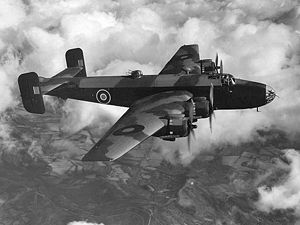
The Frisian Islands, off the Dutch coast, were a frequent
designation for “Gardening” operations by the men of the 419.
The four examples below are from only two of many many mineing
operations and yet give a brief glimpse of the types
of danger experinced in these operations to "plant the vegatables
in a row"
On the night February the 18th 1943 fighter attacks on Moose
aircraft caused the posible loss of one Halifax and
the night battle between two aircraft.
The crew of DT639 took off for a Gardening mission to the Frisian
Islands and were never heard of again. It may have been weather
conditions or they were lost to attacks by enemy night fighters is
unknown. Considering the events that occurred to another aircraft
on the very same night it could have been a single night fighter
of IV/NJG1
which reported attacking two Halifax aircraft between 2100 and 2116 close to the time of the
attack reported by F/S Goddard and the location of the attack listed in the Lufwaffe account was
just off Vlieland (West Frisian)
The crew of DT639 were
F/S Benoit Albert Levasseur, Pilot
Sgt. Griffith Arthur Lloyd Navigator(RAF)
Sgt. John William Grant, (RAF) Bomb Aimer
,
Sgt. Harold Thomas Jacobsen, W/Op.
F/S William Reid Gray , Rear Gunner
Sgt.William Albert Robinson, F/E
Sgt. Robert Potter Wilson, A/G
The Halifax flown by F/S Goddard, DT629, found it self under attack by an ME-110 showing it’s full intentions by
coming in with it’s heavy armaments in action. DT629's Rear Gunner F/S W.T Gaunt was up to the occasion forwarding needed information to the aircraft’s pilot while taking aim and firing at the attacking fighter and having such control of his guns during the twisting maneuvers of the Halifax he still managed to claim a possible on the
enemy night fighter when hits on the ME-110 were observed.
Crew of DT629 were
F/S R.G. Goddard, Pilot
Sgt. R.Johnson, Navigator
F/S H.M. Sherman, B/A
Sgt. K,I,J. Deane WAG
Sgt. W.N. Joy, F/E
Sgt. J.J. McKenzenie, A/G
F/S W.T. Gaunt R/G
On the night February the 27th another pair of incidents on 419
aircraft occured, the death of two crew members and the ditching
of yet another Halifax on the same operation.
On this night,Halifax DT619 came under fire from both a flak
ship and then cannon bursts from a night fighter killing two
members of the crew while wounding a third member of the crew.
Both Sgt. A. D. Grogan the Flight Engineer and the Rear Gunner
Sgt. G.I. Dunbar were killed in the attack. (other accounts have Sgt.
Grogan killed in the crash landing of the aircraft at Colishall)
The Navigator
Sgt. A. Mellin was badly wounded, his leg had sustained
multiple fractures with much loss of blood.
Even with this painful wound he temporarily took over the
duties of the Flight Engineer. And then resumed his navigational
duties to complete the calculations needed for pilot
Sgt. McIntosh to bring the aircraft back to RAF Colteshall.
Sgt. Mellin was still at work at his table in much pain completing
what ever duties he could to help bring the remaining crew home
safe as the Halifax came in for it's landing. For his devotion to duty Sgt. Mellin received a DFM.
It should be mentioned that three mines were still aboard
when it landed which was about 3,000 pounds of explosives
in the bomb bay of the Halifax.
Crew members of DT619
Sgt. J. McIntosh, Pilot
Sgt. A. Mellin, Navigator
Sgt. R.N. Rumsan, WAG
Sgt. Barrington Philip Grogan, F/E
Sgt. K.N. Doe, A/G
Sgt. George Irving Herbert Dunbar, R/G
On this same night operation yet another Halifax,
DT615 had to ditch after engine damage possibly from
flak bursts caused loss of height and failure of the
hydraulics. The loss of hydraulics meant that they
were unable to close the bomb doors adding extra drag
to an already slowing aircraft. The forced landing on
the water was successful and all the crew were rescued
after a cold almost certainly miserable 22 hours in their
escape dingy.
Crew members of DT615 were
Sgt. M. F. Gray, Pilot
FS C. O. Hancock, Navigator
F/O W/.J. McNicol, B/A
Sgt. G. M. Low, WAG
Sgt. C. Wilby, F/E
Sgt. M. S. Braniff, A/G
F/S R. Harling, R/G